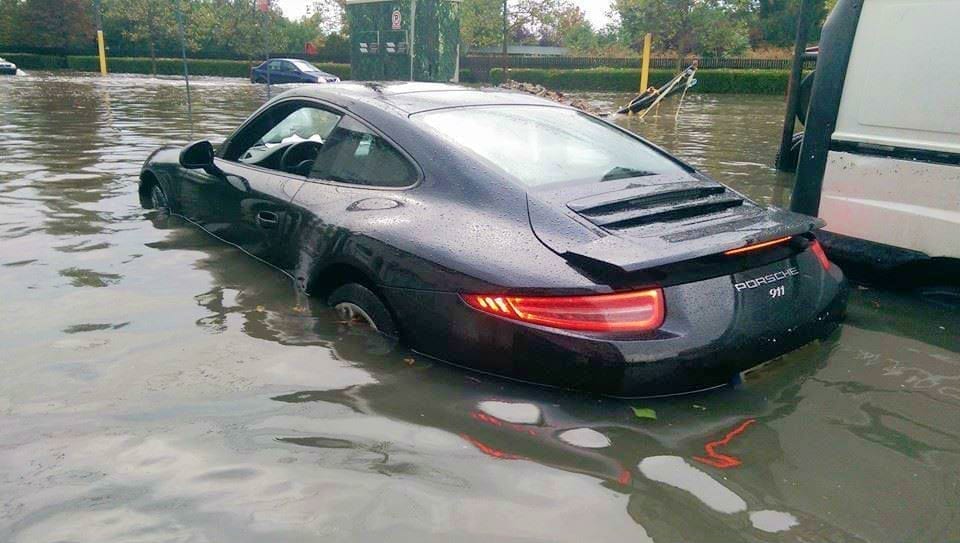As Texas continues its recovery from Harvey and Florida is just beginning its recovery from Irma, it looks as though history may repeat itself in that it will be necessary to catalog vehicles damaged by these two immense storms. This is a vitally important project, as flood damaged vehicles may not be safe, even though they appear fine.
The National Insurance Crime Bureau (NICB) teamed up with the state police in Louisiana back in 2005 after Hurricane Katrina ravaged the state. The purpose of this partnership was cataloging tens of thousands of storm damaged vehicles to make sure that they were correctly identified as damaged if and when they were put up for sale. Even with this concerted effort, vehicles damaged during Katrina were later found in twenty-six states, including California and New York. Fast forward to 2017, twelve years later, and one of the most brutal Atlantic hurricane seasons on record. In fact, this is the first time two category four hurricanes made landfall in the United States in the same hurricane season. As Texas continues its recovery from Harvey and Florida is just beginning its recovery from Irma, it looks as though history may repeat itself in that it will be necessary to catalog vehicles damaged by these two immense storms. This is a vitally important project, as flood damaged vehicles may not be safe, even though they appear fine.
According to Jonathan Smoke, chief economist for Cox Automotive, Kelley Blue Book’s parent company, Harvey has resulted in estimates of 300,000 to 500,000 destroyed vehicles in Texas, mainly Houston. The NICB estimates that 7,000 to 8,000 vehicles there were flood damaged. It’s too soon after Irma for reliable estimates of the vehicle damage in Florida. What is certain is that many vehicles were damaged or destroyed during both storms. Beyond the mess, owners are left with choices. Namely, deciding what to do with their damaged vehicles and how to go about replacing them.
The first question – what to do with a storm-damaged vehicle – is the easy one. Simply put, scrap them all. The CEO of auto retailer AutoNation, Mike Jackson, advises: “Any time you get a flood level in a vehicle above a foot or two, you really should scrap the vehicle. The damage that’s done to the electrical systems in these high-tech cars—just forget about it. They’re all going to have to be replaced.”
The second question – how to go about replacing damaged vehicles – is the trickier one. Investment banking and research firm Evercore ISI has estimated that up to one out of every seven vehicles was destroyed in the Greater Houston area alone. Again, it’s too soon to have reliable estimates on the damage in Florida. Depending on their policies, vehicle owners may be able to file insurance claims to recoup some of their losses.
The insurance companies are the final arbiters of what happens to damaged or destroyed vehicles. Many are considered total losses, marked as flood damaged, and sold for salvage. However, some of these vehicles will end up being sold as used cars. The sad part is that most of them are not safe. How do they make it back into circulation? A practice called “title washing” gives disreputable sellers all the room they need to scam unsuspecting buyers.
After a vehicle is written off as a total loss by the insurer, some states require owners to update the vehicle’s title. In those states, the vehicle is “branded,” meaning the title is stamped with a designator such as “Rebuilt,” “Salvage,” or “Junk.” Thus, anyone who wants to purchase the vehicle will see it does not have a “clean title.”
Enter our scammers. These dishonest folks know which states require branding and which don’t. So, they buy branded vehicles, typically at greatly reduced prices, and take them to a state that doesn’t require branding. There, they register the vehicle, at which point the brand is removed because the state doesn’t require it, and the vehicle is given a clean title.
What can consumers do? In the midst of tremendous amounts of paperwork, insurance claims, and the hard work of rebuilding, they must take on the additional task of informing themselves. Understandably, they need a vehicle ASAP; however, this is one time that haste truly does make waste. Flood damaged vehicles can literally be falling apart in ways that won’t be seen for years.

Consumers can use any number of helpful tools to determine whether the vehicle they want to buy really has a clean title or one that’s been washed. These tools include:
- A vehicle history report from a source such as Experian’s AutoCheck;
- The Department of Justice’s National Motor Vehicle Title Information System;
- The NICB’s VINCheck service.
Another wise action for consumers is having the vehicle thoroughly inspected by a trusted and certified mechanic. No matter how good the clean-up and repair, a good mechanic should see the signs of flood damage. The Washington Post recently published an article with more helpful information on flood damaged vehicles.
Parting words from Roger Morris, NICB communications officer: “I would advise anyone looking to buy a used car, period, to look into that vehicle’s history. Consumers should be very cautious of any used vehicle they buy in the aftermath of a flood like this. You can clean up a car pretty well, but it’s the two to three months afterward when problems really start to show up.”


Join the conversation!